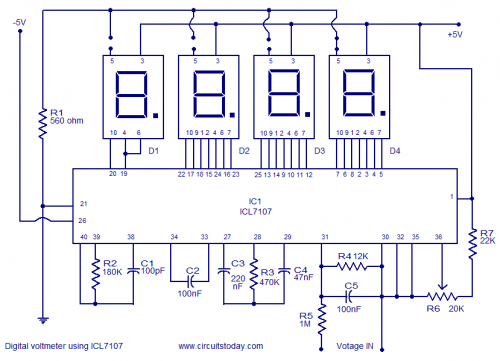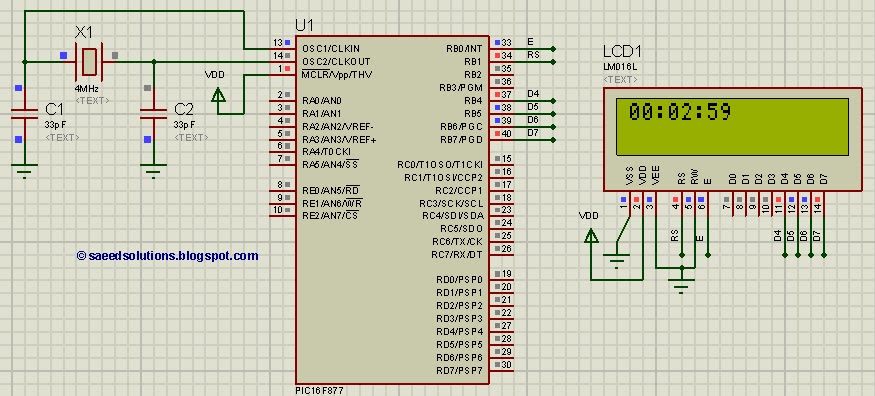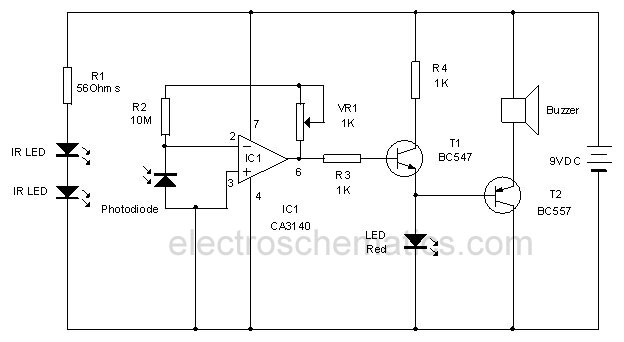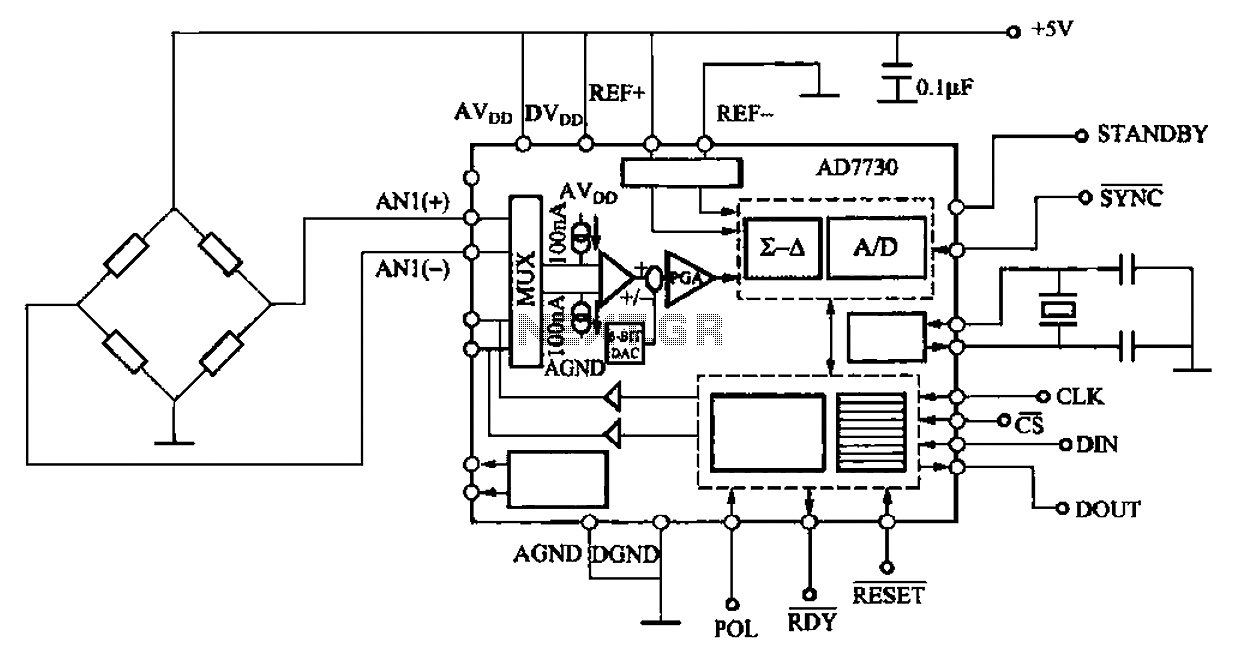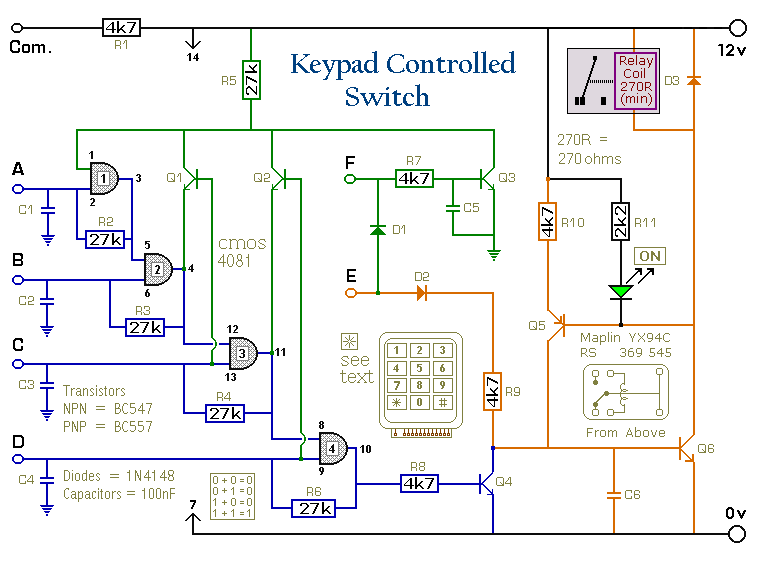
Enhanced 4 Digit Alarm Keypad
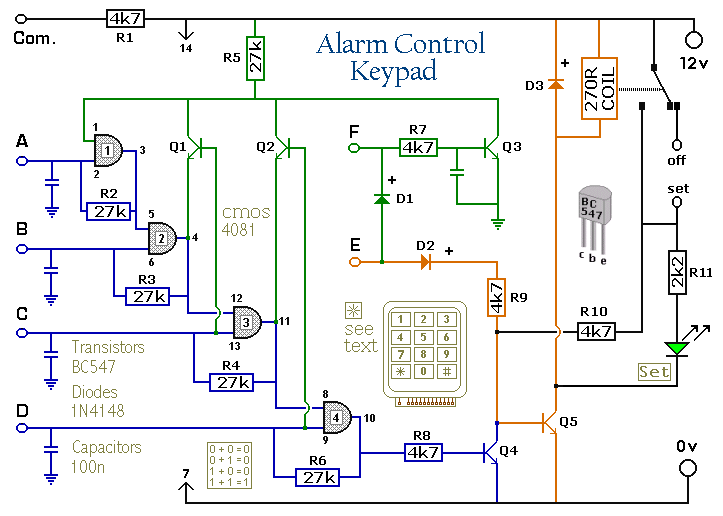
The keypad must be of the type that has a common terminal and a separate connection for each key. For a 12-key pad, there should be a total of 13 terminals. The matrix type with 7 terminals is not suitable. The alarm is activated by pressing a single key. Select the desired key for activation and connect it to terminal `E`. Choose four keys for deactivating the alarm and connect them to terminals `A`, `B`, `C`, and `D`. The code can include non-numeric symbols, and with a 12-key pad, it is possible to create over 10,000 different codes. Connect the common terminal to resistor R1 and all remaining keys to terminal `F`. When key `E` is pressed, current flows through diode D2 and resistor R9, turning on transistor Q5. This energizes the relay, which then maintains its state by providing base current to Q5 through resistor R10. The 12-volt output switches from the "off" to the "set" terminal, and the LED lights up. To deactivate the alarm, keys `A`, `B`, `C`, and `D` must be pressed in the correct order. The integrated circuit (IC) used is a quad 2-input AND gate, specifically a CMOS 4081. These gates output a high signal only when both inputs are high. Pin 1 is held high by resistor R5, enabling gate 1, so when key `A` is pressed, the output at pin 3 goes high. This output serves two functions: it locks itself high using resistor R2 and enables gate 2 by bringing pin 5 high. The remaining gates function similarly, each locking itself on through a resistor while enabling the next gate in the sequence. If the correct sequence is entered, pin 10 activates transistor Q4, grounding the base of Q5, which turns off Q5 and deactivates the relay. Any keys not connected to terminals `A`, `B`, `C`, `D`, or `E` are connected to the base of transistor Q3 via resistor R7. If any of these incorrect keys are pressed, Q3 pulls pin 1 low, disabling gate 1 and resulting in a failed code entry. If keys `C` or `D` are pressed out of sequence, transistors Q1 or Q2 will also pull pin 1 low, leading to the same failure. The code can be modified by changing the keypad connections. For a more secure code, a larger keypad with additional incorrect keys connected to `F` can be used; a 16-key pad allows for over 40,000 different codes. All components are positioned flat on the board, though some are mounted upright. The links are bare copper wires on the component side, and two links must be installed before the IC. The support material for this circuit includes a step-by-step guide for constructing the circuit board, a parts list, and a detailed circuit description.
The described circuit functions as a secure alarm system utilizing a keypad interface for activation and deactivation. The choice of a keypad with a common terminal and independent key connections allows for a flexible design that supports a wide range of codes. The use of a quad 2-input AND gate (CMOS 4081) for logic processing ensures that the alarm can only be deactivated with the correct sequence of key presses, providing a safeguard against unauthorized access.
The circuit's design incorporates a relay for the alarm mechanism, which is energized by the output of the AND gates. The relay's ability to hold its state is critical for maintaining the alarm's active status until the correct deactivation sequence is entered. The inclusion of diodes and resistors in the circuit helps to manage the current flow and protect the components from potential damage due to incorrect key presses.
The system's flexibility is enhanced by the option to change the keypad connections, allowing users to customize their security codes easily. The potential for using a larger keypad increases the complexity of the code, providing an additional layer of security. The layout of components on the circuit board, including the strategic placement of links and the requirement for certain links to be installed before the IC, reflects careful consideration of assembly and functionality.
In summary, this circuit design effectively combines keypad input with logical processing to create a robust alarm system, capable of supporting a high degree of customization while ensuring security through a structured deactivation protocol.The Keypad must be the kind with a common terminal and a separate connection for each key. On a 12-key pad, look for 13 terminals. The matrix type with 7 terminals will NOT do. The Alarm is set by pressing a single key. Choose the key you want to use and wire it to `E`. Choose the four keys you want to use to switch the alarm off, and connect them to `A B C & D`. Your code can include the non-numeric symbols. With a 12-key pad, over 10 000 different codes are available. Wire the common to R1 and all the remaining keys to `F`. When `E` is pressed, current through D2 and R9 switches Q5 on. The relay energises, and then holds itself on by providing base current for Q5 through R10. The 12-volt output is switched from the "off " to the "set " terminal, and the LED lights. To switch the Alarm off again it is necessary to press A, B, C & D in the right order. The IC is a quad 2-input AND gate, a Cmos 4081. These gates only produce a high output when both inputs are high. Pin 1 is held high by R5. This `enables` gate 1, so that when `A` is pressed, the output at pin 3 will go high. This output does two jobs. It locks itself high using R2 and it enables gate 2 by taking pin 5 high. The remaining gates operate in the same way, each locking itself on through a resistor and enabling its successor. If the correct code is entered, pin 10 will switch Q4 on and so connect the base of Q5 to ground. This causes Q5 to switch off and the relay to drop out. Any keys not wired to `A B C D or E` are connected to the base of Q3 by R7. Whenever one of these `wrong` keys is pressed, Q3 takes pin 1 low. This removes the `enable` from gate 1, and the code entry process fails. If `C` or `D` is pressed out of sequence, Q1 or Q2 will also take pin 1 low, with the same result. You can change the code by altering the keypad connections. If you need a more secure code use a bigger keypad with more `wrong` keys wired to `F`. A 16-key pad gives over 40 000 different codes. All components are shown lying flat on the board; but some are actually mounted upright. The links are bare copper wires on the component side. Two of the links must be fitted before the IC. The Support Material for this circuit includes a step-by-step guide to the construction of the circuit-board, a parts list, a detailed circuit description and more.
🔗 External reference
The described circuit functions as a secure alarm system utilizing a keypad interface for activation and deactivation. The choice of a keypad with a common terminal and independent key connections allows for a flexible design that supports a wide range of codes. The use of a quad 2-input AND gate (CMOS 4081) for logic processing ensures that the alarm can only be deactivated with the correct sequence of key presses, providing a safeguard against unauthorized access.
The circuit's design incorporates a relay for the alarm mechanism, which is energized by the output of the AND gates. The relay's ability to hold its state is critical for maintaining the alarm's active status until the correct deactivation sequence is entered. The inclusion of diodes and resistors in the circuit helps to manage the current flow and protect the components from potential damage due to incorrect key presses.
The system's flexibility is enhanced by the option to change the keypad connections, allowing users to customize their security codes easily. The potential for using a larger keypad increases the complexity of the code, providing an additional layer of security. The layout of components on the circuit board, including the strategic placement of links and the requirement for certain links to be installed before the IC, reflects careful consideration of assembly and functionality.
In summary, this circuit design effectively combines keypad input with logical processing to create a robust alarm system, capable of supporting a high degree of customization while ensuring security through a structured deactivation protocol.The Keypad must be the kind with a common terminal and a separate connection for each key. On a 12-key pad, look for 13 terminals. The matrix type with 7 terminals will NOT do. The Alarm is set by pressing a single key. Choose the key you want to use and wire it to `E`. Choose the four keys you want to use to switch the alarm off, and connect them to `A B C & D`. Your code can include the non-numeric symbols. With a 12-key pad, over 10 000 different codes are available. Wire the common to R1 and all the remaining keys to `F`. When `E` is pressed, current through D2 and R9 switches Q5 on. The relay energises, and then holds itself on by providing base current for Q5 through R10. The 12-volt output is switched from the "off " to the "set " terminal, and the LED lights. To switch the Alarm off again it is necessary to press A, B, C & D in the right order. The IC is a quad 2-input AND gate, a Cmos 4081. These gates only produce a high output when both inputs are high. Pin 1 is held high by R5. This `enables` gate 1, so that when `A` is pressed, the output at pin 3 will go high. This output does two jobs. It locks itself high using R2 and it enables gate 2 by taking pin 5 high. The remaining gates operate in the same way, each locking itself on through a resistor and enabling its successor. If the correct code is entered, pin 10 will switch Q4 on and so connect the base of Q5 to ground. This causes Q5 to switch off and the relay to drop out. Any keys not wired to `A B C D or E` are connected to the base of Q3 by R7. Whenever one of these `wrong` keys is pressed, Q3 takes pin 1 low. This removes the `enable` from gate 1, and the code entry process fails. If `C` or `D` is pressed out of sequence, Q1 or Q2 will also take pin 1 low, with the same result. You can change the code by altering the keypad connections. If you need a more secure code use a bigger keypad with more `wrong` keys wired to `F`. A 16-key pad gives over 40 000 different codes. All components are shown lying flat on the board; but some are actually mounted upright. The links are bare copper wires on the component side. Two of the links must be fitted before the IC. The Support Material for this circuit includes a step-by-step guide to the construction of the circuit-board, a parts list, a detailed circuit description and more.
🔗 External reference

